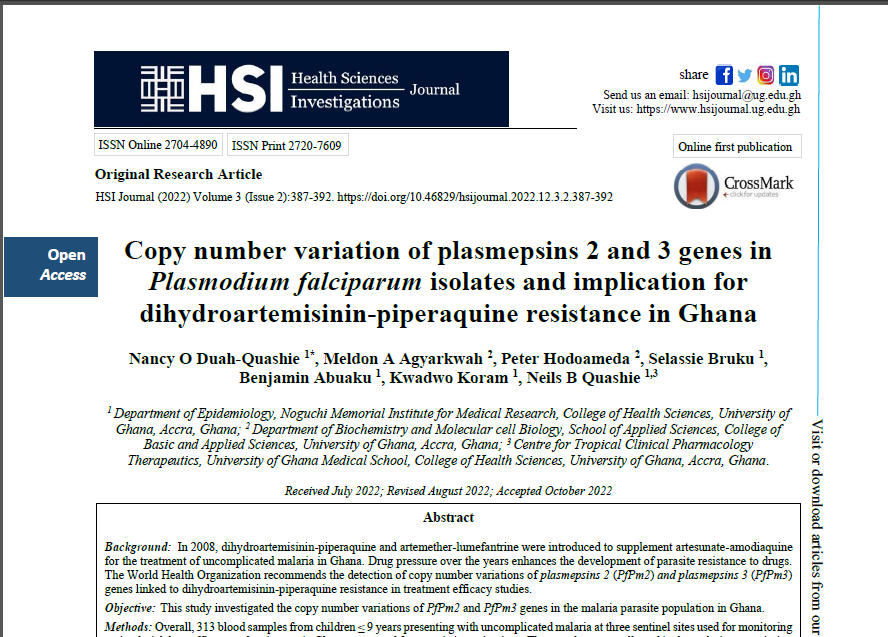Copy number variation of plasmepsins 2 and 3 genes in Plasmodium falciparum isolates and implication for dihydroartemisinin-piperaquine resistance in Ghana
Molecular markers of dihydroartemisinin-piperaquine resistance in Plasmodium falciparum
Abstract
Background: In 2008, dihydroartemisinin-piperaquine and artemether-lumefantrine were introduced to supplement artesunate-amodiaquine for the treatment of uncomplicated malaria in Ghana. Drug pressure over the years enhances the development of parasite resistance to drugs. The World Health Organization recommends the detection of copy number variations of plasmepsins 2 (PfPm2) and plasmepsins 3 (PfPm3) genes linked to dihydroartemisinin-piperaquine resistance in treatment efficacy studies.
Objective: This study investigated the copy number variations of PfPm2 and PfPm3 genes in the malaria parasite population in Ghana.
Methods: Overall, 313 blood samples from children ≤ 9 years presenting with uncomplicated malaria at three sentinel sites used for monitoring antimalarial drug efficacy and resistance in Ghana were used for genetic investigations. The samples were collected in the malaria transmission seasons of 2015 and 2016. Malaria parasite DNA extraction from the blood samples followed by real-time quantitative PCR was used to determine the copy number of the PfPm2 and PfPm3 genes. The gene copy number was calculated by the relative expression formula 2-ΔΔCt for quantification, where ΔΔ is the relative delta-delta, and Ct is the cycle threshold. ΔΔCt was calculated as (Ctβ-tubulin − Ctpfpm2/3) - (Ctβ-tubulin cal − Ctpfpm2/3 cal), where cal is the calibration control of genomic 3D7 DNA with one copy of both the β-tubulin endogenous control and pfpm2 and pfpm3. A change in Ct (ΔCt = Ct PfPm2/3 - Ct Pfβ-tubulin) where is the difference in Ct values for the target gene of interest PfPm2 and PfPm3 and the reference gene Pfβ-tubulin. Statistical significance was defined as p < 0.05.
Results: Of the parasites analyzed, 79.2% (n = 228/288) and 80.5% (n = 227/282) had one gene copy for PfPm2 and PfPm3, respectively. For PfPm2, 14.9% (n = 43/288), 3.8% (n = 11/288), and 2.1% (n = 6/288) of the isolates had copy numbers 2, 3 and 4 respectively. For PfPm3, gene copies of 2, 3 and 4 were observed in 16.3% (n = 46/282), 2.1% (n = 6/282), and 1.1% (n = 3/282) of isolates. Analysis of the copy number variation across the three study sites in Cape-Coast, Begoro, and the Navrongo areas showed no significant difference for PfPm2 (p = 0.93) and PfPm3 (p = 0.94) genes.
Conclusion: After over a decade of the use of dihydroartemisinin-piperaquine, the mutations associated with resistance to the drug have been observed in Ghanaian P. falciparum isolates. This serves as baseline data for further monitoring of this molecular marker extensively as part of ongoing surveillance of antimalarial drug efficacy studies in Ghana.


